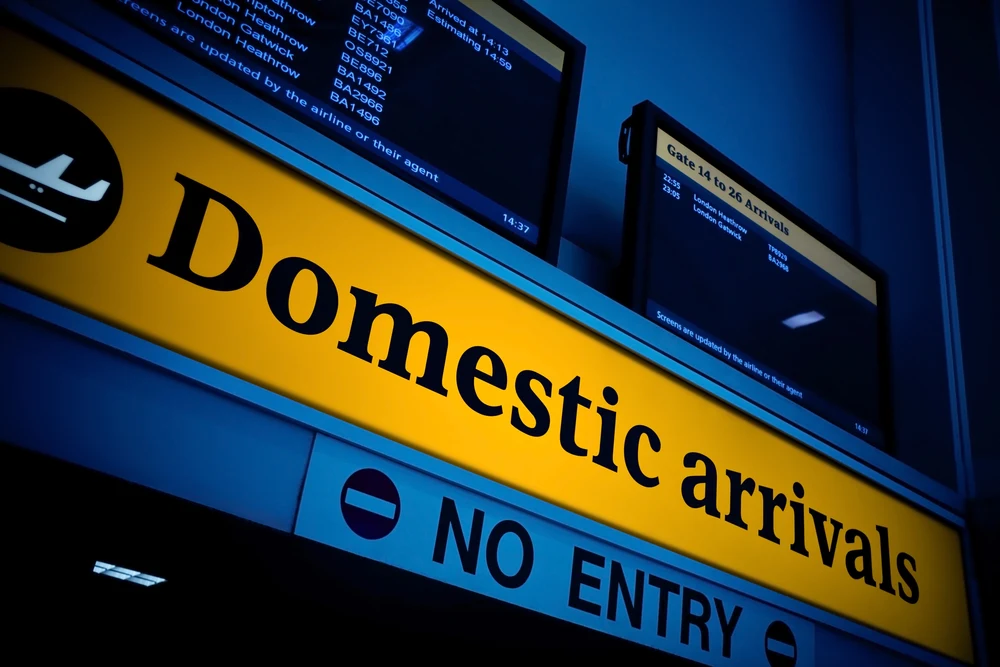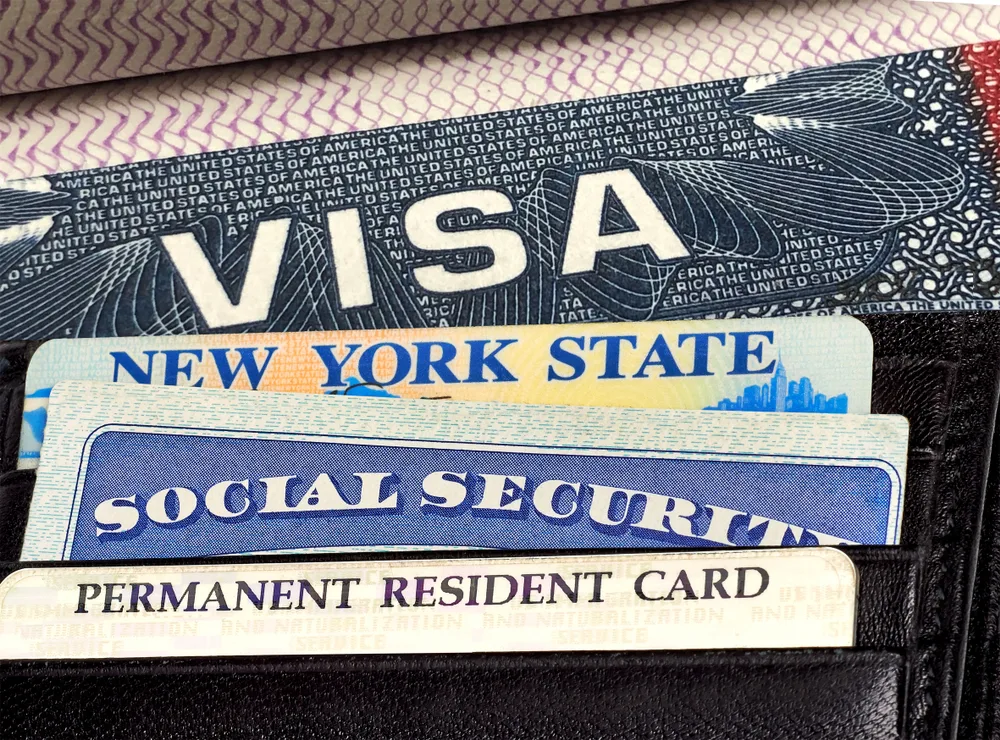What is domestic travel?
Domestic travel means traveling entirely within the borders, states, territories, or possessions of your home country. For the US, this includes all 50 states plus 16 US territories like Puerto Rico and Guam. The meaning of domestic travel usually matters most for flights and passport requirements.
Many people dive into the world of wanderlust and wonder, “What is domestic travel?” Learn what domestic travel means, domestic travel requirements in the US, and tips for smoother travel in this guide.
We’ll help you understand what’s considered domestic travel, the differences between domestic and international travel, and common questions about traveling domestically below.
Pro Tip: Easily the best destinations to visit using our simple destination finder tool!
What Is Domestic Travel?

Brian A Jackson/Shutterstock
The meaning of domestic travel is simply any travel that takes place within the states or territories of the US or your home country. “Domestic” comes from the Latin domus, meaning home.
Domestic travel includes moving within or between states, territories, and US possessions freely without a passport. When you travel domestically, it may be by plane, car, train, boat, or bus.
So what countries and territories are considered domestic travel for US citizens? Take a look at the list below:
- United States (all 50 states)
- American Samoa
- Baker Island
- Guam
- Howland Island
- Jarvis Island
- Johnston Atoll
- Kingman Reef
- Micronesia
- Marshall Islands
- Midway Islands
- Navassa Island
- Northern Marianas
- Palau
- Palmyra Atoll
- Puerto Rico
- U.S. Virgin Islands
- Wake Island
Traveling to or within these destinations is considered domestic travel, not international, since they are all states, territories, possessions, or entities with a free association status with the United States.
But here’s where it can get confusing.
Some domestic travel, like driving from the United States to Alaska, does require you to cross an international border (as you will when you drive through Canada to reach Alaska) along the way.
In cases like these, you may need some form of identification outside of a driver’s license or social security card.
A passport is always considered acceptable ID, but you can also provide a US birth certificate as ID to cross the Canadian border on a trip to Alaska.
Here’s another example to help you understand what the umbrella term of domestic travel covers for US travelers.
Say that you own multiple houses in different neighborhoods and states. You can freely go to any of these homes, no matter where they’re located or how far away from your residence they are, because they’re all owned by you.
It’s the same with domestic travel in the US.
The US “owns” or possesses some states and territories outside of its contiguous boundaries, but you’re still allowed to go to those destinations without a passport because they’re all under the umbrella of US ownership.
Domestic Travel vs. Trans-Border Travel

ehrlif/Shutterstock
You might wonder if traveling from the USA to a destination in Canada or Mexico is considered domestic travel. Technically, traveling from the USA to Canada or USA to Mexico is considered international travel. Some people call it “trans-border travel.”
Trans-border travel is a subset of international travel. It refers to traveling between your home country and another country that shares a border with your home country.
It’s still considered international travel and you’ll need a passport for it, but you’ll sometimes hear this kind of travel distinctively recognized as trans-border travel.
- A trip from the US to Canada is trans-border, international travel
- A trip from the US to Alaska through Canada is domestic travel
- A trip from the US to Mexico is trans-border, international travel
Domestic Travel vs. International Travel
Domestic travel differs from international travel because domestic travel happens only within states, territories, or possessions of the United States while international travel happens in other countries and their respective territories.
With domestic travel, your start and end points are both part of US territory. With international travel, your start or end points are within another country’s borders.
- A trip from the US to France is international travel
- A trip from the US to Guam (US territory) is domestic travel
- A trip from the US to Japan is international travel
US Domestic Travel Requirements

M. Unal Ozmen/Shutterstock
The question, “What is domestic travel?” isn’t the only thing travelers wonder about. You need to clear on the US domestic travel requirements to avoid unexpected travel hiccups and a last-minute scramble for documents.
In general, the only requirement for domestic travel to or within US states, territories, or possessions is proper identification if you’re 18 or older. Children do not need these forms of ID.
Accepted forms of identification at US airports for domestic travel includes the following:
- Driver’s license or state ID issued by the DMV or equivalent
- U.S. passport or passport card
- U.S. DOD identification
- Trusted traveler cards from the DHS (NEXUS, SENTRI, FAST, etc.)
- Permanent resident card
- Border crossing card
- Photo ID from federally-recognized Tribal Nation
- HSPD-12 PIV card
- Foreign government-issued passport
- Canadian driver’s license
- Indian and Northern Affairs Canada card
- Transportation worker credentials
- U.S. Citizenship and Immigration Services Employment Authorization Card
- U.S. Merchant Mariner Credential
- Veteran Health Identification Card
Any of these forms of identification is considered acceptable for domestic travel. You only need 1 acceptable form of ID to get through airport security for domestic flights.
It’s a little-known fact that the Transportation Security Administration (TSA) will accept an expired driver’s license as identification for domestic travel as long as your driver’s license or state-issued ID expired less than 1 year ago.
If you forget to bring your driver’s license or other ID, all is not lost. The TSA can have you complete an ID verification process by supplying your name, address, and personal information to confirm that you are who you say you are.
If this happens to you, there might be additional security measures to go through, like a pat-down or additional carry on bag screening.
Is REAL ID Required for Domestic Travel?
REAL ID will soon be required for domestic travel, but as of right now, any state-issued ID or driver’s license is acceptable. REAL ID requirements will kick in on May 7, 2025.
On and after May 7, 2025, US travelers will need to have a REAL ID-compliant driver’s license or identification card in order to board a domestic or international flight in the US.
What ID Is Not Accepted for Domestic Travel?
What’s not considered acceptable ID? Anything not on the list above shouldn’t be considered proper ID for domestic airport travel in the US.
That means temporary driver’s licenses and weapons permits are not acceptable forms of ID for domestic travel. If your identity can’t be verified with ID or an identification verification process, you won’t be allowed to board your domestic flight.
Frequently Asked Questions

AbElena/Shutterstock
What is domestic travel in the US? What are some examples of domestic travel? Take a look at the most frequently asked questions below to learn more.
What is the meaning of domestic travel?
Domestic travel means traveling entirely within the borders, states, territories, or possessions of your home country. For the US, this includes all 50 states plus 16 US territories like Puerto Rico and Guam.
The meaning of domestic travel usually matters most for flights and passport requirements.
Domestic flights don’t require passports because they don’t involve departing from or arriving in international airports, only airports within US states or territories.
What is an example of domestic travel?
Traveling from Ohio to Florida, from Montana to Alaska, or even from California to Puerto Rico are examples of domestic travel.
Domestic travel can even refer to traveling within a single state, like traveling from New York City, NY to Buffalo, NY.
What is considered U.S. domestic travel?
If you won’t touch down in a foreign territory or country at any point during your trip, it’s considered domestic travel.
Domestic travel doesn’t require a passport unless that’s what you choose to use for your form of ID at an airport.
What is international vs. domestic travel?
International travel involves crossing into a foreign country’s territory or arriving in a foreign country’s airport.
Traveling from the US into France is considered international travel because France is not a US state or territory.
Is Hawaii considered a domestic flight?
Yes, flying to Hawaii from the United States is considered a domestic flight. Since Hawaii is a US state, US citizens don’t need a passport to fly there from the US.
If you travel from Hawaii to a foreign country, like the Philippines, that would be considered international travel and require a passport.
Quick Recap: What Is Domestic Travel?
Untangling what domestic travel is – and what it isn’t – will help you properly plan for your upcoming travels to US states and territories.
Now you know that domestic travel involves traveling entirely within your home country’s states, borders, or within territories or possessions your country owns.
When you travel domestically in the US, that can mean traveling to another city in your state, to another state (contiguous or noncontiguous), or to a US territory like Puerto Rico, Guam, or American Samoa.
The major benefit of domestic travel? You don’t need a passport to do it and it’s often a lot cheaper than international travel. With so many amazing US vacations to choose from, domestic travel can be really interesting and fun!



